
11 minute read
HALLMARK OF A UNIVERSITY
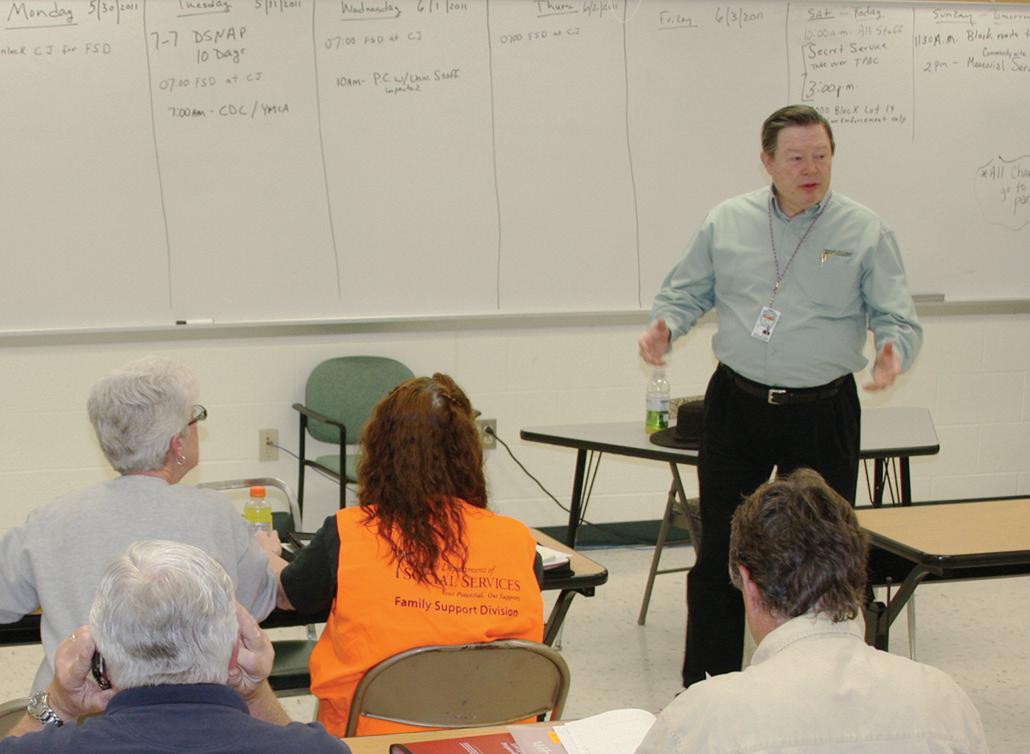
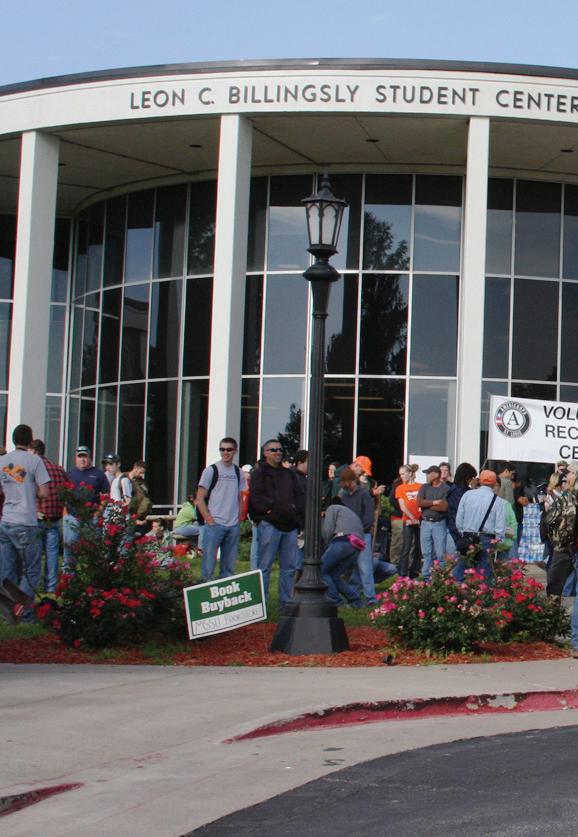
Advertisement
Left, University President Bruce Speck conducts an organizational meeting with staff during the week of May 22. Center, Speck and Vice President for Academic Affairs AJ Anglin visit with U.S. Rep. Billy Long (R-Mo.). Right, Volunteers gather outside of Billingsly Student Center on May 24.
Service: The hallmark of a university
On May 22 at 5:41 p.m., an EF-5 tornado struck Joplin, Missouri, wreaking havoc over a business and residential area three-quarters of a mile wide and 14 miles long in the center of the city and beyond. Thankfully, Missouri Southern State University was untouched and became an integral part of the relief effort that immediately began.
Our MSSU family — students, staff, faculty — responded to the extraordinary circumstances by working with local, state and federal agencies to provide desperately needed services. Southern partnered with government and private agencies alike to meet the needs of area residents in the aftermath of this historical storm.
We are particularly proud of our MSSU family and the way it responded to help those in need. We believe the heart of a university is service to others and that was demonstrated time and time again in the hours, days and weeks that followed the tornado.
Countless people went above and beyond the call of duty, and while we call these people heroes, they do not. Rather, they consider themselves ordinary folks who saw a multitude of human needs and responded in a selfless approach — ordinary service in a time of extraordinary circumstances. We admire them for that attitude.
MSSU became a focal point after the storm because it had signed a Memorandum of Understanding with the Greater Ozarks Regional Chapter of the American Red Cross establishing the university as a disaster shelter just three weeks before the tornado touched down. Red Cross officials were at the university within hours and kicked into action their plan to provide cots, blankets and other aid to tornado survivors. Young Gymnasium and Leggett & Platt Athletic Center provided a place to meet the immediate needs of citizens brutalized by the tornado. People flooded in, many dazed by the abrupt change in their lives, all seeking comfort, assurance and help. At one point, almost 500 individuals were housed at the shelter.
With such a short period of time between signing the MOU and the disaster, the customary time used to develop a detailed plan about that partnership was shortened. Those logistical challenges were intensified by the extent of the devastation. More than 8,000 homes and 500 businesses were destroyed, including schools and churches. Approximately 16,000 vehicles were mangled or made unusable. One of the two primary hospitals was destroyed as well as many dental and medical offices. And, 161 people died from injuries received that night. Communication was difficult at best. Two power stations had been lost and cell phones functioned intermittently because towers were damaged. During the first two weeks, managing a fragmented and constantly shifting communication flow was a challenge.
Despite these challenges, it was not surprising to us that the MSSU family jumped to action without prompting. For example, Dean of Arts & Sciences Richard Miller was at the shelter immediately after it opened, helping set up cots. It wasn’t until the next day that we learned he had lost his house in the tornado, stepping out of the only room that remained after the whirlwind passed. He and his wife, Cindi, a nurse, made their way to the university to help others.
The athletic complex was the center of the immediate efforts to provide solace, and many university hands ensured people’s needs were met. The crush of people, some with critical and special needs, taxed the facilities to the point that our custodians, working with little or no sleep, hauled water from the indoor swimming pool to help flush toilets because the water system in Joplin had been compromised. A boil water order was also in effect.
The 24-hour operation of the athletic facilities required constant monitoring by our department of public safety, physical plant director, athletic facility manager, and public safety officer. Pulling double or triple shifts, employees and students treated those from outside the campus as family, providing for them the comfort and assistance that was vital for their wellbeing in the face of an event that left many traumatized.
People from other agencies pulled us aside and told us how helpful MSSU family members were in solving problems, how cheerful, never passing the buck, never say-
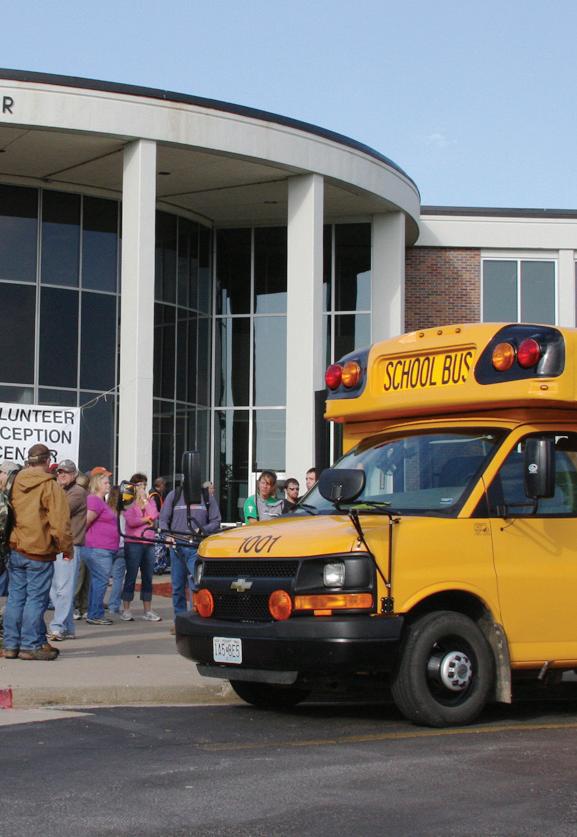
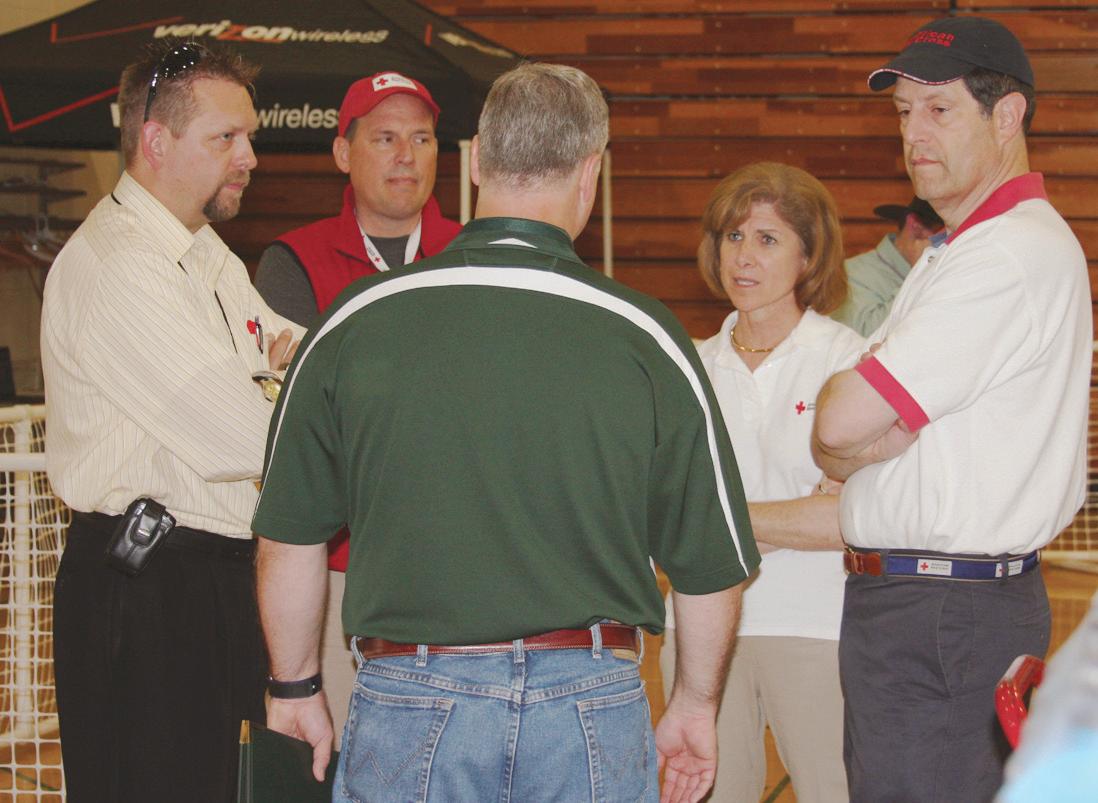
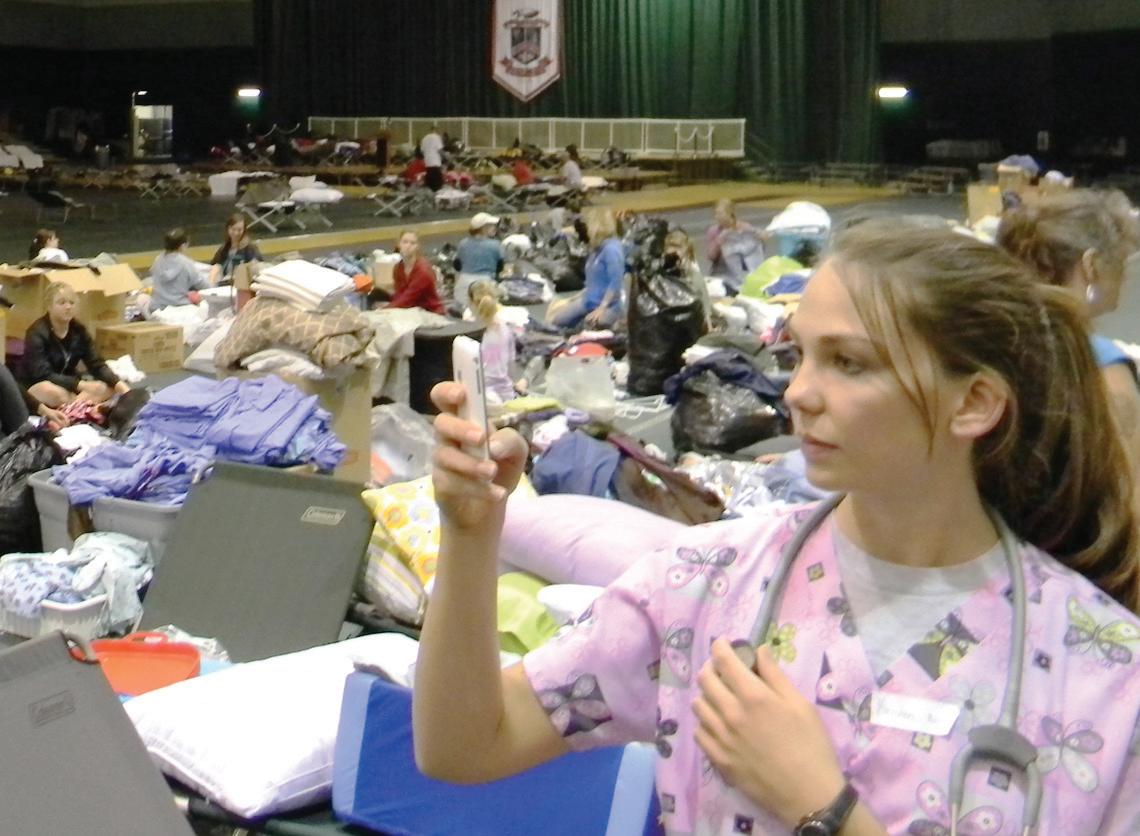
Center, Athletic Director Jared Bruggeman and Vice President for Student Services Darren Fullerton, ’88, discuss details related to the Red Cross shelter. Right, a medical professional checks her cell phone in Leggett & Platt Athletic Center, where the shelter was set up for Joplin area residents.
Ordinary people, extraordinary circumstances and public service define the Missouri Southern State University family.
ing go somewhere else for an answer. This essential. Director of University Relations and starting Sunday evening until the early can-do approach to helping others amazed and Marketing Rod Surber met each day at hours of Monday morning, our employees those unfamiliar with our campus and con- 6 a.m. in the EOC with representatives from worked at the Beimdiek Recreation Center, firmed to us, as insiders, that service really emergency response agencies involved in where AmeriCorps established a processis a hallmark of the university’s commit- the crisis to glean the latest. Our athletic ing center to register and deploy volunment to the community. facilities became a place for administrative teers. A recent graduate and member of the
Many individuals served for long meetings, where fragile communication Student Senate worked through the night stretches in difficult circumstances, but so was pieced together and actions coordi- until sufficient AmeriCorps personnel were many others volunteered to help. The shel- nated between university leadership and in place. By Monday morning, our parkter required all kinds of attention, and those emergency response personnel. ing lots and streets around the center filled at MSSU who could put their work on hold Many people coming to the shelter with thousands of volunteers, ready and to volunteer did so. needed medical attention. Dean of Technol- eager to help. That magnitude of volunteers Our facilities served multiple func“Pulling double or triple shifts, employees and students treated continued throughout the week. tions: a shelter for hundreds of people those from outside the campus as family, providing for them the At one point, Director of IT Al Stadler (including individu- comfort and assistance that was vital for their well-being in the had been running on als who had pets) where three meals a face of an event that left many traumatized.” adrenalin during a 36hour stint. His departday were provided, a ment was the one that day care center, counseling, an aid station, ogy Tia Strait arrived on campus within could command the resources to get the safe-and-well registration, phone and com- hours and mobilized the Health Sciences job done. The entire IT department labored puter banks, among other functions. Building to provide medical care. Since above and beyond to provide essential A crush of local, national and interna- the shelter and Health Sciences Building communication support, especially during tional news coverage hit the area. Our me- are only 50 yards apart, citizens who had a time when the communication network in dia relations department assisted Red Cross medical needs were escorted to the facility, Joplin was crippled. officials in managing media requests for which served as a 28-bed hospital. MSSU Hotels quickly filled in Joplin, and interviews with Red Cross shelter residents. health care faculty, staff and students MSSU remained the only option for police, Personnel from the MSSU Foundation, worked side-by-side with other profession- fire and search and rescue teams that came Alumni Association, University Relations als — physicians, pharmacists, nurses — to to help. Our 700-bed residence halls were and Marketing, Department of Communi- treat physical and emotional needs. Again, filled to capacity during the first three cations, as well as alumni and volunteers, because of the continuous flow of acute weeks of the disaster, and because we had pitched in to respond to media requests. trauma, we found MSSU faculty and staff graduated our seniors the day before the
During the crisis, we found that keep- sleeping on cots to catch a few winks before storm hit and we were not in session, we ing in the flow of communication with the resuming volunteer duties. had limited staff in the residence halls. Emergency Operations Center in Joplin was AmeriCorps was also quick to respond, Residence Assistants who had just finished
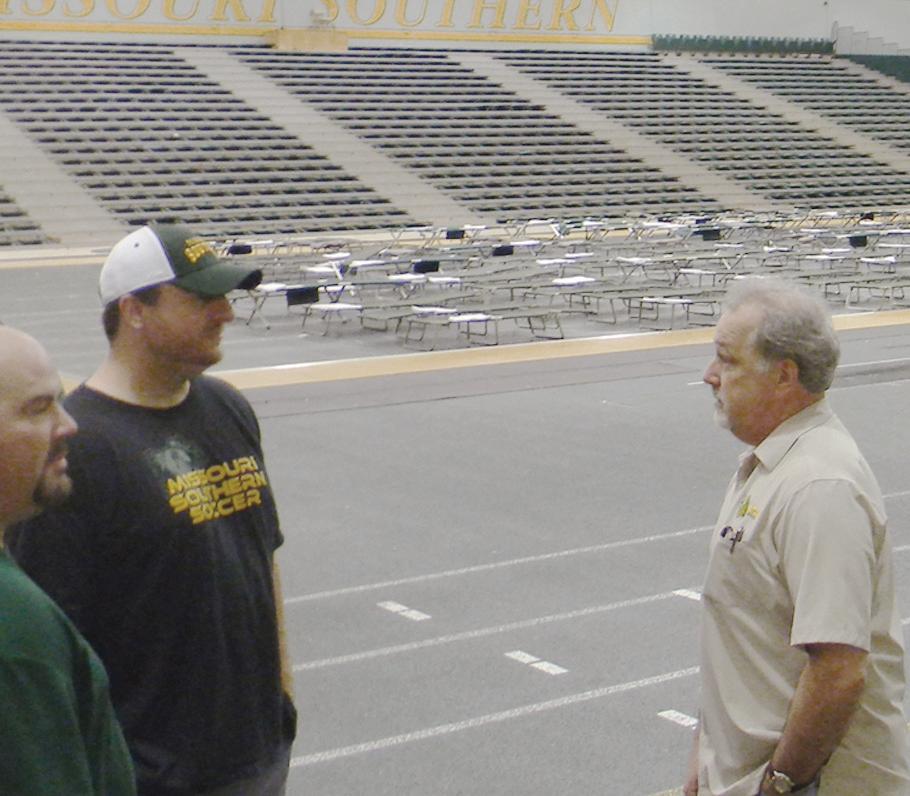
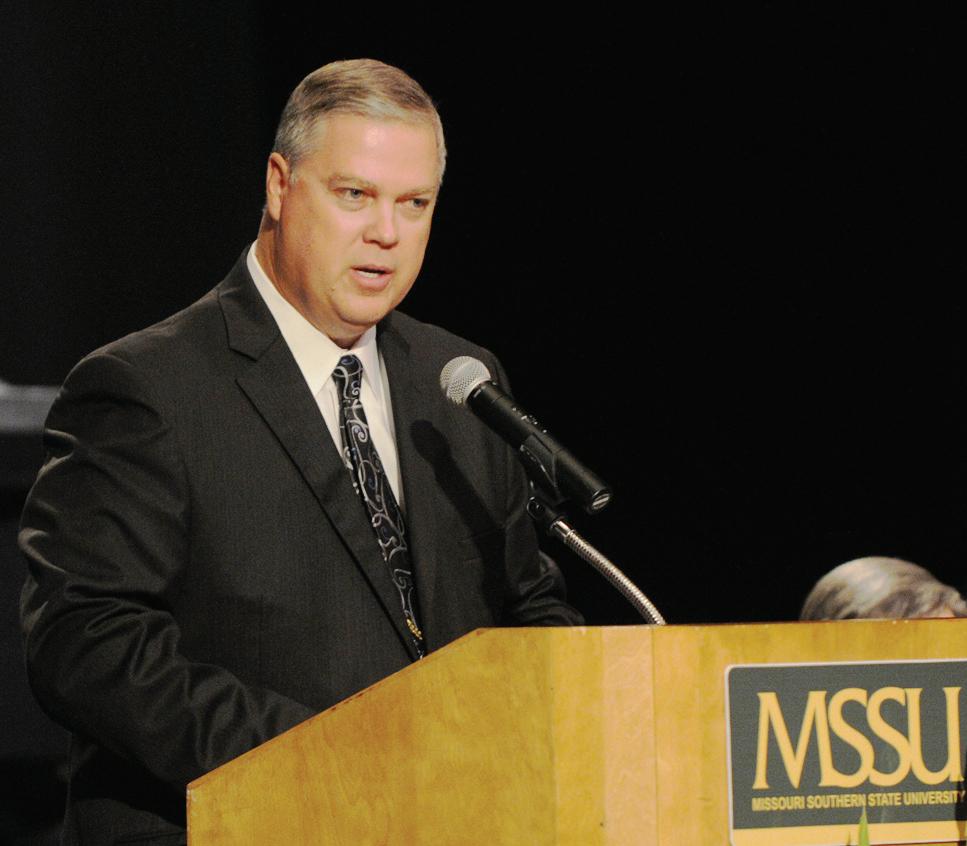
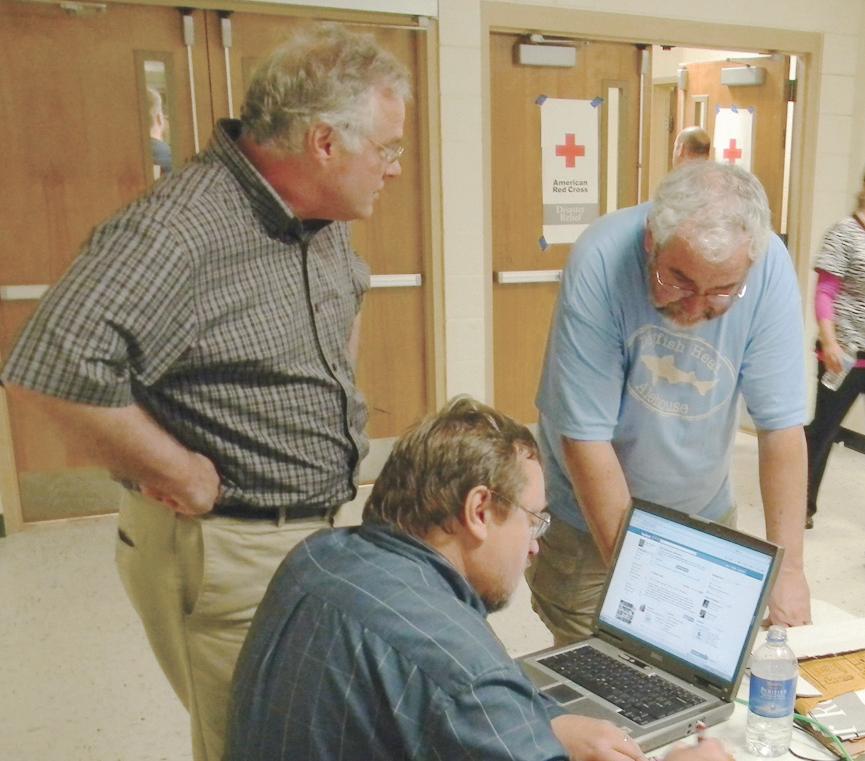
Left, Fullerton, ’88, speaks at the campus memorial service on August 28 in Taylor Auditorium. Center, Vice President for Business Affairs Rob Yust, ’80, (right) discusses the set up of Leggett & Platt for the shelter. Right, former Vice President for Development Mark Parsons and Stephen Smith, ’77, news bureau manager, assist Dean of Arts and Sciences Richard Miller, who lost his home on May 22. — Photos by Mike Gullett and Lee & Wyrsch
their semester’s duties were asked to help were doing whatever was needed to help funding so these resources can be used with the influx of first responders to the victims find a sense of balance as they wisely to alleviate some of our people’s residence halls. Without pay or the hope of lived amid the ruins that once were their suffering. pay, those RAs worked tirelessly, process- homes and businesses. We knew members of the MSSU family ing emergency personnel in and out of the While all this was happening to help would need to deal with their own perresidence halls. the community, university staff also began sonal issues, so we authorized up to 120
Many other facilities were used, and the important task of reaching out to stu- additional hours of paid leave for faculty university family members pitched in to dents, faculty and staff to determine who and staff who experienced personal injury help as the campus became busier during had suffered losses due to the tornado. or whose home was either destroyed or the weeks after the disaster. Corley Audi- Departments within the university met to damaged. All employees were given an torium, which seats about 400, was used create a campus assistance call center, a additional 80 hours of paid time to volunfor events, including Missouri Governor student assistance form, and an employee teer in disaster-related activities to assist Jay Nixon’s initial meeting to present a assistance form to enable the university to friends, family or community. The addiplan for directing the recovery efforts in collect information about members of the tional hours of paid leave and paid time Joplin. Our media staff met for volunteer service extends the needs of the Governor’s Office and other state of“Our people served with distinction even though they until the end of the 2012 fiscal year. In addition, faculty and fices that conducted press persist in considering themselves ordinary citizens staff invited some university conferences on recovery who were pressed into service by their own sense of families who lost homes to issues, including the Missouri Department of Public compassion and duty during a time of crisis.” move into their homes. We have only touched Safety’s efforts in reducing upon a few of the stories of the unaccounted-for-per- ordinary people serving their sons list from more than 1,500 to zero. MSSU family. Although we had kept a re- community during extraordinary circum-
Another component of the university’s cord of needs as we found out about them, stances. Volumes could be written — and service to the community was hosting a the formal process of soliciting information probably should be written — about memorial service in Taylor Auditorium. confirmed to us that, sadly, MSSU family individual acts of kindness, fortitude, Anticipating an overflow crowd, we estab- members had not been unscathed by the poise under pressure, and incredible selflished four live-feed locations on campus devastation. sacrifice that were witnessed throughout to accommodate the people — in excess of Faculty member Dr. José Alvarez; Don campus in the weeks after one of the worst 7,000 — who turned out to hear President Lansaw, husband of staff member Bethany natural disasters in U.S. history. Obama and Governor Nixon deliver inspi- Lansaw; and student Abraham Khoury Our people served with distinction, rational messages. We were humbled and died from tornado-related injuries. More even though they persist in considering grateful to provide a place to memorialize than 130 university family members lost themselves ordinary citizens who were our fellow citizens. homes, and a score of others sustained pressed into service by their own sense
But our people did not limit their par- significant damage to their dwellings. of compassion and duty during a time of ticipation in the relief effort to the campus. Within 24 hours, the Missouri Southern crisis. Players and coaches from the football and Foundation established a Tornado Emer- — By Missouri Southern President’s Council women’s basketball teams were out clear- gency Relief Fund to assist these individuing debris, as were many of our faculty, als with immediate needs. A representative The MSSU President’s Council is led by Dr. staff and students. Our students willingly committee of students, staff and faculty Bruce W. Speck and includes Dr. AJ Anglin, and eagerly logged thousands of hours has distributed the majority of those funds Jared Bruggeman, Darren Fullerton, ’88, Dr. of service since the May 22 tornado. They and continues to evaluate applications for Mark Parsons, and Rob Yust, ’80.

